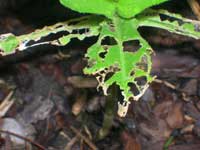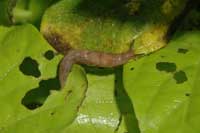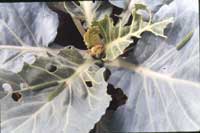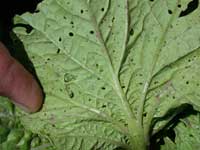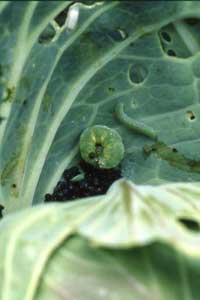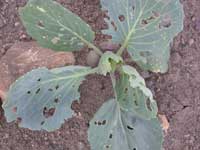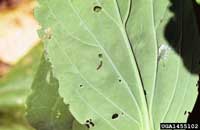Extension > Garden > Diagnose a problem > What's wrong with my plant? > Vegetable > Lettuce and Endive > Holes in leaves
Lettuce and Endive > Leaves > Holes in leaves
1 of 6
Slugs
- Chews irregular holes in leaves; can completely defoliate plants
- Feeds during night and typically not seen during day
- 1/4 to 2 inches long
- Soft-bodied and typically brown or gray
- Active spring and summer; is particularly common during cool, wet weather
- More information on Slugs
2 of 6
Imported Cabbageworm
Artogeia rapae
- Larvae feed on leaves causing irregularly shaped holes
- Larvae are up to 1 inch in length, velvety green in color with faint yellow stripes running longitudinally on the back and sides
- Larvae are present throughout the growing season
- Brown droppings may be seen
- More information on Imported Cabbageworm
3 of 6
Flea Beetles
Disonycha xanthomelas, Systena blanda, and
Phyllotreta spp.
- Adult feeding on leaves creates shallow pits and small, irregular holes giving it a "shot hole" appearance
- Heavy feeding may cause wilting
- Adults are small (1/16 to 1/8 inch long), and vary in color from black, bronze, bluish, or brown to metallic gray, while some species have stripes
- Present throughout the growing season
- More information on Flea Beetles
4 of 6
Cabbage Looper
Trichoplusia ni
- Larvae feed on leaves resulting in large ragged holes
- Dark green droppings may be seen
- Larvae are up to 1 ½ inches in length, light green, and move in a characteristic "looping" action
- Present from early July to late August
- More information on Cabbage Looper
5 of 6
Diamondback Moth
Plutella xylostella
- Larvae feed on leaves, turning tissue opaque/white color
- Affected tissue eventually falls out resulting in small holes
- Larvae are up to 1/3 inch and pale green in color
- Present throughout the growing season
- More information on Diamondback Moth
6 of 6
Anthracnose
Microdochium panattonianum
- Somewhat circular dry brown leaf spots
- Sunken oval dark lesions form on midrib and larger leaf veins
- Center of leaf spot turns white and falls out, leaves appear 'shot hole'
- In severe cases outer leaves wilt
- More information on Anthracnose



